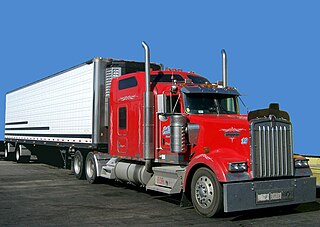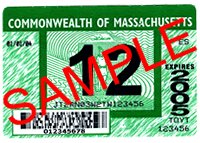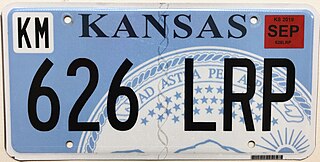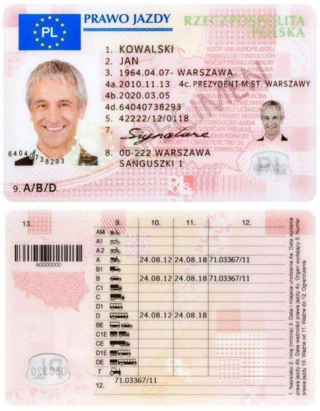Related Research Articles

An L-plate is a square plate bearing a sans-serif letter L, for learner, which must be affixed to the front and/or back of a vehicle in many countries if its driver is a learner under instruction, or a motorcycle rider with provisional entitlement to ride restricted motorcycles.

A commercial driver's license (CDL) is a driver's license required in the United States to operate large and heavy vehicles or a vehicle of any size that transports hazardous materials or more than 15 passengers.
In the United States, vehicle registration plates, known as license plates, are issued by a department of motor vehicles, an agency of the state or territorial government, or in the case of the District of Columbia, the district government. Some Native American tribes also issue plates. The U.S. federal government issues plates only for its own vehicle fleet and for vehicles owned by foreign diplomats. Until the 1980s, diplomatic plates were issued by the state in which the consulate or embassy was located.
Graduated driver licensing systems (GDLS) are designed to provide new drivers of motor vehicles with driving experience and skills gradually over time in low-risk environments. There are typically three steps or stages through which new drivers pass. They begin by acquiring a learner's permit, progress to a restricted, probationary or provisional license, followed by receipt of a full driver's license. Graduated drivers' licensing generally restricts nighttime, expressway, and unsupervised driving during initial stages, but lifts these restrictions with time and further testing of the individual, eventually concluding with the individual attaining a full driver's license.
A driver's permit, learner's permit, learner's license or provisional license is a restricted license that is given to a person who is learning to drive, but has not yet satisfied the prerequisite to obtain a driver's license. Having a learner's permit for a certain length of time is usually one of the requirements for applying for a full driver's license. To get a learner's permit, one must typically pass a written permit test, take a basic competency test in the vehicle, or both.
Hoy No Circula is the name of an environmental program intended to improve the air quality of Mexico City. A similar coordinated program operates within the State of México, which surrounds Mexico City on three sides. Mexico City and Mexico State have reciprocal agreements with surrounding states that also have emissions testing programs to permit their residents to travel freely without restriction.

Vehicle inspection is a procedure mandated by national or subnational governments in many countries, in which a vehicle is inspected to ensure that it conforms to regulations governing safety, emissions, or both. Inspection can be required at various times, e.g., periodically or on the transfer of title to a vehicle. If required periodically, it is often termed periodic motor vehicle inspection; typical intervals are every two years and every year. When a vehicle passes inspection, often a sticker is placed on the vehicle's windshield or registration plate to simplify later controls, but in some countries—such as the Netherlands since 1994—this is no longer necessary. Most US inspection decals/stickers display the month's number and the year.

The U.S. state of Kansas first required its residents to register their vehicles and display license plates in 1913. Plates are currently issued by the Kansas Department of Revenue through its Division of Vehicles and only rear plates have been required since 1956.

Driver licences in Australia refer to the official permit required for a person to legally drive a motor vehicle in Australia. The issue of driver licences, alongside the regulation and enforcement of road use, are all managed by state and territory governments.

In the United States, driver's licenses are issued by each individual state, territory, and the District of Columbia rather than by the federal government due to federalism. Drivers are normally required to obtain a license from their state of residence. All states of the United States and provinces and territories of Canada recognize each other's licenses for non-resident age requirements. There are also licenses for motorcycle use. Generally, a minimum age of 16 is required to apply for a non-commercial driver's license, and 18 for commercial licenses which drivers must have to operate vehicles that are too heavy for a non-commercial licensed driver or vehicles with at least 16 passengers or containing hazardous materials that require placards. A state may also suspend an individual's driving privilege within its borders for traffic violations. Many states share a common system of license classes, with some exceptions, e.g. commercial license classes are standardized by federal regulation at 49 CFR 383. Many driving permits and ID cards display small digits next to each data field. This is required by the American Association of Motor Vehicle Administrators' design standard and has been adopted by many US states. According to the United States Department of Transportation, as of 2018, there are approximately 227 million licensed drivers in the United States.

In Canada, driver's licences are issued by the government of the province or territory in which the driver is residing. Thus, specific regulations relating to driver's licences vary province to province, though overall they are quite similar. All provinces have provisions allowing non-residents to use licences issued by other provinces and territories, out-of-country licences, and International Driving Permits. Many provinces also allow non-residents to use regular licences issued by other nations and countries. Canadian driver's licences are also valid in many other countries due to various international agreements and treaties.
In India, a driving license is an official document that authorises its holder to operate various types of motor vehicles on highways and some other roads to which the public has access. In various Indian states, they are administered by the Regional Transport Authorities/Offices (RTA/RTO). A driving licence is required in India by any person driving a vehicle on any highway or other road defined in the Motor Vehicles Act, 1988. This act sets limits on the minimum age for vehicle operation ranging from 16 to 20, depending on specific circumstances. A modern photo of the driving licence can also serve many of the purposes of an identity card in non-driving contexts such as proof of identity or age.
A driving licence in Singapore is required before a person is allowed to drive a motor vehicle of any description on a road in the country. Like many other countries in the world, an individual must possess a valid driving licence before being permitted to drive on the road, and driving licence holders are subject to all traffic rules.

In the United Kingdom, a driving licence is the official document which authorises its holder to operate motor vehicles on highways and other public roads. It is administered in England, Scotland and Wales by the Driver and Vehicle Licensing Agency (DVLA) and in Northern Ireland by the Driver & Vehicle Agency (DVA). A driving licence is required in England, Scotland, and Wales for any person driving a vehicle on any highway or other "road", as defined in s.192 Road Traffic Act 1988, irrespective of the ownership of the land over which the road passes. Similar requirements apply in Northern Ireland under the Road Traffic Order 1981.
Vehicle registration plates of Canada, also known as license plates, are issued by provincial or territorial government agencies. Registration plates in Canada are typically attached to motor vehicles or trailers for official identification purposes. Some Canadian registration plates have unique designs, shapes, and slogans related to the issuing jurisdiction. For example, registration plates issued in the Northwest Territories are shaped like a polar bear. In Alberta, registration plates typically display the words "Wild Rose Country."

The U.S. state of New Jersey first required its residents to register their motor vehicles in 1903. Registrants provided their own license plates for display until 1908, when the state began to issue plates.

Driving licences in Hong Kong are issued by the Transport Department. A full driving licence is valid for 10 years and is compulsory in order to drive a motor vehicle. Most driving licences are issued after the applicant passed a driving test for the respective type of vehicles. They may be issued without a test if the applicant is a holder of an overseas driving licence issued on passing a driving test in an approved country.

Driving licence in Thailand is a document that allows the holder to drive on any roads in Thailand and in other ASEAN states without an International Driving Permit. The minimum age to drive a motor vehicle is 18, and to drive a motorcycle is 15. Driving licence is issued and administered by the Department of Land Transport, Ministry of Transport and its branches, land transport offices across Thailand.

A driver's license or driving permit is a legal authorization, or the official document confirming such an authorization, for a specific individual to operate one or more types of motorized vehicles—such as motorcycles, cars, trucks, or buses—on a public road. Such licenses are often plastic and the size of a credit card.
A Lebanese driving licence is a driving licence issued by the government of Lebanon. It authorises its holder to operate various types of motor vehicles on highways and some other publicly accessible roads. It is issued by each individual district.
References
- ↑ "Young driver decals mandatory May 1". News 12 New Jersey. March 8, 2010. Archived from the original on July 11, 2012. Retrieved March 8, 2010.
- ↑ S2314
- ↑ "Kyleigh's Law: Protecting - or Targeting - Young New Jersey Drivers - Law Firm Drazin and Warshaw P.C. Attorneys Red Bank, New Jersey". Archived from the original on 2012-10-17. Retrieved 2012-08-05.
- ↑ "New York City and Tri-State News from WABC-TV 12/22/06 | 7online". Archived from the original on January 24, 2013. Retrieved August 5, 2012.
- ↑ https://web.archive.org/web/20100414120953/http://www.northjersey.com/news/opinions/phalons_file/89658602_A_dangerous_law.html. Archived from the original on April 14, 2010. Retrieved April 14, 2010.
{{cite web}}: Missing or empty|title=(help) - ↑ "N.J. officials reveal Kyleigh's Law license plate decals for young drivers". 25 March 2010.
- ↑ https://web.archive.org/web/20120910175130/http://www.northjersey.com/news/crime_courts/safety/89658602_A_dangerous_law.html. Archived from the original on September 10, 2012. Retrieved April 18, 2010.
{{cite web}}: Missing or empty|title=(help) - ↑ http://www.dailyrecord.com/article/20100428/UPDATES01/100428055/1005/NEWS01/National+youth+rights+group+urges+NJ+drivers+to+sabotage++Kyleigh+s+Law+%5B%5D
- ↑ "N.J. parents, teens protest against Kyleigh's Law at Morris County lawmakers' offices". 14 May 2010.
- ↑ "N.J. Supreme Court upholds decal law for young drivers". 7 August 2012.